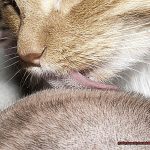Cats are truly fascinating creatures with their unique personalities and adorable quirks.
They can be playful, affectionate, and even a little bit mischievous at times. But have you ever witnessed your feline friend licking concrete?
It may seem like an odd behavior, but it’s more common than you might think. At first glance, seeing a cat lick concrete might raise some concerns about their health or well-being.
However, there are actually several reasons why cats engage in this behavior. Animal behaviorists have put forth various theories to explain this curious habit, ranging from seeking out essential minerals to satisfying grooming instincts.
In this blog post, we’ll explore the reasons why cats lick concrete and what it could potentially mean for their overall health. We’ll delve into the potential risks and benefits of this behavior and provide tips on how to discourage excessive licking in your furry friends.
In this post, you’ll have a better understanding of your feline companion’s habits and behaviors – including why they might occasionally indulge in a good tongue-lashing of the pavement.
Is Licking Concrete Harmful for Cats?
While concrete itself may not be toxic, there are a few important factors you should consider.
Firstly, the rough texture of concrete can cause wear and tear on a cat’s teeth. Over time, this can lead to dental issues such as cracked or broken teeth, which can be painful and require veterinary attention.
Another concern is the potential for harmful chemicals like lead to be present in older homes or buildings. If ingested over time, this can cause toxicity in cats.
Additionally, cats who lick concrete may accidentally ingest small pieces of debris or sharp edges, which can cause internal damage or blockages. Moreover, outdoor concrete surfaces may harbor bacteria or other harmful pathogens that can make cats sick.
If a cat licks a contaminated surface, they could potentially contract an illness or infection. While there may be some potential benefits to licking concrete, like the essential minerals it contains, it’s important to prioritize your cat’s safety and health.
Providing alternative safe and healthy chewing options for cats may also help redirect their attention away from concrete surfaces.
Could It Be Related to Taste or Texture?
While it may seem like an unlikely snack for our feline friends, there are several theories as to why they are drawn to its taste or texture.
One possible explanation is that cats may be instinctually seeking out minerals found in concrete, such as calcium, which is an essential nutrient for their diet. As natural hunters and scavengers, cats may be looking to supplement their diet with these important minerals.
Another theory is that cats simply enjoy the sensation of licking rough or gritty surfaces. As creatures with rough tongues designed for grooming, they may find the texture of concrete satisfying in some way.
Perhaps it’s a form of sensory stimulation, similar to how we might enjoy the crunch of potato chips. However, it’s important to note that excessive licking of non-food items, including concrete, can be a sign of pica in cats.
This behavior is often associated with underlying medical conditions such as anemia or gastrointestinal issues. If you notice your cat engaging in this behavior frequently, it’s important to consult with a veterinarian to rule out any underlying health concerns.
In addition, it’s important to prioritize your cat’s safety and well-being by providing them with alternative chewing options.
Concrete poses several potential hazards for our furry friends, including dental issues, ingestion of debris or sharp edges causing internal damage or blockages, and outdoor concrete surfaces that may harbor dangerous bacteria.
Could It Be Related to Coolness on Hot Days?
It turns out that cats have a knack for seeking out cool areas to regulate their body temperature, and licking concrete may be one way they do so.
Concrete surfaces tend to be cooler than other surfaces, especially when shaded. Thus, they become an attractive option for felines looking to cool down.
Furthermore, concrete may retain moisture, which provides extra relief on hot days. So, if you see your cat licking concrete, they might be trying to chill.
However, it’s crucial to note that licking concrete isn’t always the best way for cats to stay cool. Concrete can be abrasive and cause damage to a cat’s tongue or teeth over time.
Therefore, it’s essential to provide your furry friend with plenty of cool options like shaded areas or cool water sources and monitor their behavior to ensure they are not putting themselves in harm’s way. Sometimes cats may also enjoy licking concrete because of the taste or texture.
The material may contain minerals or other substances that appeal to them, and some cats just love the sensation of licking rough surfaces. However, if your cat is exhibiting excessive licking behavior, it’s vital to consult with a veterinarian to rule out any underlying medical conditions that may be causing the behavior.
What Should I Do if My Cat is Licking Concrete?
If you’ve noticed your cat licking concrete, it’s important to take action.
Concrete can contain harmful chemicals and bacteria that can be dangerous for your cat’s health. To start, try to figure out why your cat is licking the concrete.
If they’re thirsty, make sure they have access to fresh water at all times. Consider providing a water fountain or multiple water bowls throughout your home.
If boredom or stress is the issue, provide them with more mental and physical stimulation such as interactive toys, scratching posts, and playtime with you. But don’t stop there.
It’s crucial to keep an eye on your cat’s behavior and health. If they continue to lick the concrete or show any signs of illness like vomiting or diarrhea, take them to the vet for a check-up.
The best way to prevent your cat from licking concrete is by creating a safe and stimulating environment for them. Make sure they have access to fresh water and plenty of toys to keep them occupied.
Also Read: Why Do Cats Lick Concrete?
Conclusion
To sum it up, cats never cease to amaze us with their peculiar habits and behaviors.
One such behavior is their tendency to lick concrete, which may seem bizarre to us humans. However, there are several reasons behind this behavior that we can decipher.
For instance, cats may be seeking essential minerals present in the concrete or satisfying their grooming instincts. While licking concrete itself may not pose any immediate danger, it’s crucial to be aware of the potential risks associated with it.
The rough texture of concrete can lead to dental issues, while ingestion of harmful chemicals or bacteria can cause toxicity or illness. As a responsible pet owner, you must prioritize your cat’s safety and health by providing them with alternative safe chewing options and seeking veterinary attention if necessary.
By observing your cat closely and understanding their behavior, you can ensure their happiness and well-being. Creating a safe and stimulating environment for them with access to fresh water and plenty of toys can prevent excessive licking behavior.
To conclude, even though the reasons why cats lick concrete may remain somewhat mysterious, taking steps to keep them healthy and happy should always be a top priority for any pet owner.







